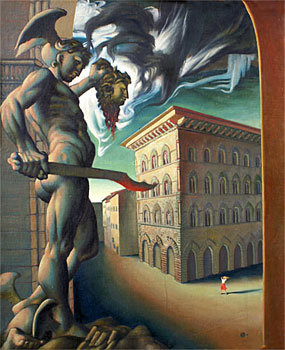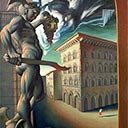Perseus
89 x 74 cm
est. $45,000 -70,000
Born in Southland, Edward Bullmore died in the North, in Rotorua, at the tragically young age of 45 after study at the Canterbury University College School of art, teaching in Tauranga and ten years in Europe. In 1959 he was in Florence and Perseus is a brilliant result of that period of study and development.
Edward Bullmore has often been portrayed as a New Zealand surrealist but in the wonderful work here the concern with architecture, the curious perspective of the classically inspired subject, would tend to indicate Perseus to be an inspired example of Metaphysical painting, not Surrealism, and De Chirico springs to mind.
In the Bullmore we have a similar eerie light, we have the long shadow created by a female figure in a red skirt and white blouse; a classical reference in the subject of the mighty Perseus holding the Gorgon Medusa's head. Before she arrived in the sorry state we see her now Medusa was capable of turning people to stone should they cast her eyes upon her and her hair of writhing snakes! Perseus was noted for his strength and cunning which he used to advantage by surveying this hideous creature by the reflection in the silver of his shield.
Note the wings on the back of his ankles and the winged hat, the hat of invisibility, so handy in desperate situations, and kindly provided to him by the god Mercury who also took it upon himself to provide him with the curved sword.
Not one to take a risk, Perseus averts his eyes, not so much in deference to the intimacy of birth - the winged horse Pegasus is coming into the world from the bleeding neck - but just in case Medusa still held on to her innate ability to turn viewers to stone!
The contrapposto, the highly tuned musculature, the subject, all are classical references. Bullmore has been inspired by the late Renaissance/Mannerist sculptor, Benvenuto Cellini, whose Perseus is still on show in the Loggia dei Lanzi in Florence. Indeed in Bullmore's work, as we gaze, from the vantage point of the bodily heap of lesser lights who have succumbed to the Gorgon's spell, over to the building diagonally opposite, the classical references continue in the Renaissance architecture typical of de Chirico, but not of the Surrealists.
But not all is as it seems. Yes, we have the large overhanging cornice so dear to Renaissance architects and extensively used in Florence where Bullmore and his wife were living in 1959. But there is something not quite right. An arcade of arches form the entrance to the ground floor, but the arches are Gothic, not Renaissance, and the arcade is blind. How do we get in? We can see the round Roman arches in the upper floors, a characteristic of the classical Renaissance but, in addition, we have the pointed ones of the previous era, the Gothic; Renaissance and Gothic mixed together. Is Edward Bullmore playing a linguistic joke? The eerie feel does come through in the bluish haze, the swirling Rubenesque mass of Pegasus taking form, the miniscule female (is it Andromeda waiting to be rescued?), but just in case this haunted aspect is not enough, Bullmore gives us Gothic arches and in doing so increases the haunted, gothic feel.
Mystery and hallucination belong to both the metaphysical painting of de Chirico and to the work of the Surrealists but of the two styles, only metaphysical painting can lay claim to classical references and an interest in architectural as well as pictorial structure, a feature of Italian Renaissance art which had its first flowering in Florence. Here we see a brilliant example of Edward Bullmore as a metaphysical artist from the Florentine period of 1959.
The 1960s were spent in London where Bullmore's work takes on a more distinctly Surrealist feel. He could give free rein to the subconscious in this city open to psychic and erotic adventurism in art, something that could not be said of New Zealand at the time. His work in this area in Britain saw success for him in various galleries, and took another positive step when the film director Stanley Kubrick acquired two of his works. Indeed one of them is seen in his film A Clockwork Orange. Angela Ashford





